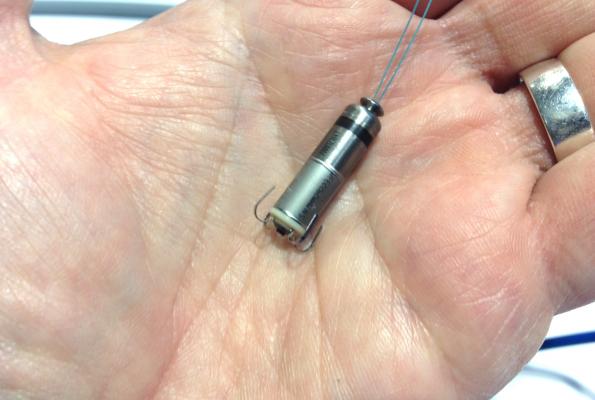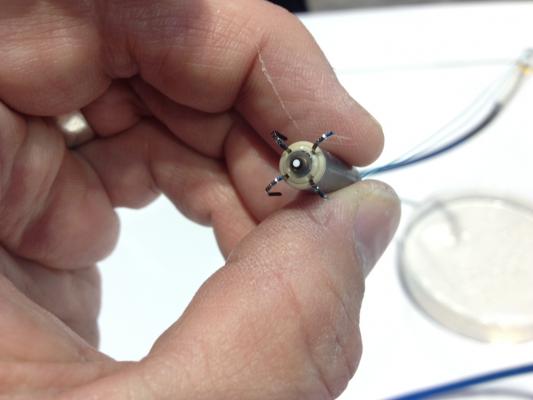
The Medtronic Micra leadless pacemaker is the smallest pacemaker in the world. (Photo by Dave Fornell)
May 16, 2017 - The preliminary results for the Medtronic Micra Transcatheter Pacing System (TPS) Post-Approval Registry showed a 99.6 percent implant success rate and a low rate of major complications (1.51 percent) at 30 days in a diverse, real-world patient population. The study was presented in a late-breaking clinical trial session at Heart Rhythm 2017, the Heart Rhythm Society's 38th Annual Scientific Sessions, and simultaneously published in Heart Rhythm.
"It is encouraging to see these strong outcomes with such a novel technology in the hands of new implanting physicians," said Mikhael El-Chami, M.D., director of electrophysiology at Emory Midtown and associate professor of medicine at Emory University School of Medicine in Atlanta. "The high implant success and low major complication rates in a real-world patient population reinforce the positive results seen in the investigational Micra clinical trial."
The global Micra Post-Approval Registry is an ongoing, prospective single-arm observational study designed to assess the safety and effectiveness of the Micra TPS in the post-approval setting. Data presented at HRS were from an interim analysis of 795 patients treated by 149 physicians at 97 centers across 20 countries worldwide, which assessed system or procedure-related major complications through 30 days following implant. These rates were then compared to the major complication rates of the Micra Investigational Device Exemption study (IDE).
More than 20 percent of patients in the Micra Post-Approval Registry study had at least one condition that did not allow the use of a transvenous pacemaker including history of infection or compromised venous access. Nearly 87 percent of the physicians in the analysis were new implanters with no previous experience with Micra.
Major complications were low, with 1.51 percent of patients experiencing a major complication at 30 days post-implant (95 percent CI: 0.78 percent to 2.62 percent). There were low rates of cardiac perforation or prefusion (0.13 percent), device dislodgement (0.13 percent), and infection (0.13 percent), and no (0 percent) major complications related to battery or telemetry issues. When compared to the IDE study, the rate of major complications in this real-world registry trended lower after adjusting for differences in baseline patient characteristics (1.51 vs. 2.89 percent; odds ratio = 0.59, 95 percent CI: 0.27, 1.27; P=0.18).
As operators gain more experience with the Micra, they found it may be safer to implant the system on the septal side of the right ventricle. Medtronic said 53 percent of the implants in the post-market study were septal side implants. Some operators at Heart Rhythm expressed concerns of implanting the device in the apex due to the thinner tissue in that area of the heart.
Watch a VIDEO showing how to implant the Micra pacemaker.
About the Micra Pacemaker
Approved by the U.S. Food and Drug Administration in April 2016 for patients who need a single-chamber pacemaker, the Micra TPS is the first and only leadless pacemaker approved for use in the U.S. Comparable in size to a large vitamin, the Micra TPS is less than one-tenth the size of traditional pacemakers, yet delivers the most advanced pacing technology to patients via a minimally invasive approach. During the implant procedure, it is attached to the heart with small tines and delivers electrical impulses that pace the heart through an electrode at the end of the device.
Unlike traditional pacemakers, the Micra TPS does not require leads or a surgical pocket under the skin, so potential sources of complications related to such leads and pocket are eliminated - as are any visible signs of the device.
The Micra design incorporates a retrieval feature which can be enabled, if possible; however, the device is designed to be left in the body. For patients who need more than one device, the miniaturized Micra TPS can be permanently turned off, allowing it to remain in the body so a new device can be implanted without risk of electrical interaction.
The Micra TPS is the first and only leadless pacing system to be approved for both 1.5 and 3 Tesla full-body magnetic resonance imaging (MRI) scans. It is designed to allow patients to be followed by their physicians and send data remotely via the Medtronic CareLink Network. Remote monitoring of Micra devices is expected to be available in the U.S. later this year.
Primary results from the Medtronic Micra TPS Global Clinical Trial, published in November 2015 in the New England Journal of Medicine, showed the Micra TPS was successfully implanted in 99.2 percent of patients by 94 physicians around the world and that the system met its safety and effectiveness endpoints at six months follow-up with wide margins. Long-term results from the Micra Trial, published in November 2016 in Heart Rhythm, reinforced these data, showing the risk of major complications at 12 months for Micra patients was low at four percent, 48 percent lower than for patients with traditional pacemakers (hazard ratio: 0.52, 95 percent CI: 0.35-0.77, P=0.001).
Medtronic said the goal of the Micra was to remove the need for leads and a surgical pocket, which could reduce complications for pacemaker implantation and management by 50 percent.
As of May 2017m there are more than 6,000 patients implanted with the Micra system world-wide, Medtronic said.
Single-chamber Pacemaker Market
The Micra is a single-chamber pacemaker. These devices only account for about 15 percent of the U.S. pacemaker market. Medtronic said they see the system as a stepping stone platform to the next generation of cardiac pacing. This may include the implantation of a Micra pacemaker in each ventricle of the heart and enabling wireless communications between the devices to synchronize their pacing.
Read the article “Leadless Pacemaker Gains Medicare Reimbursement.”
Read the article "One-Year Results for Micra TPS Pacemaker Trial Presented at ESC 2016."
Read about the Abbott/St. Jude headless pacemaker system in the article “New Data Showcases Long-term Benefits of Nanostim Leadless Pacemaker.”
For more information: www.medtronic.com



 November 12, 2025
November 12, 2025 









